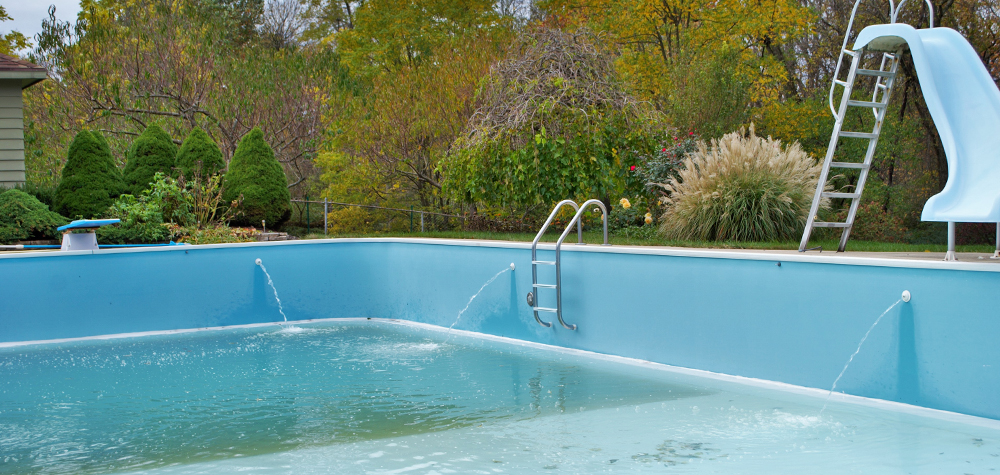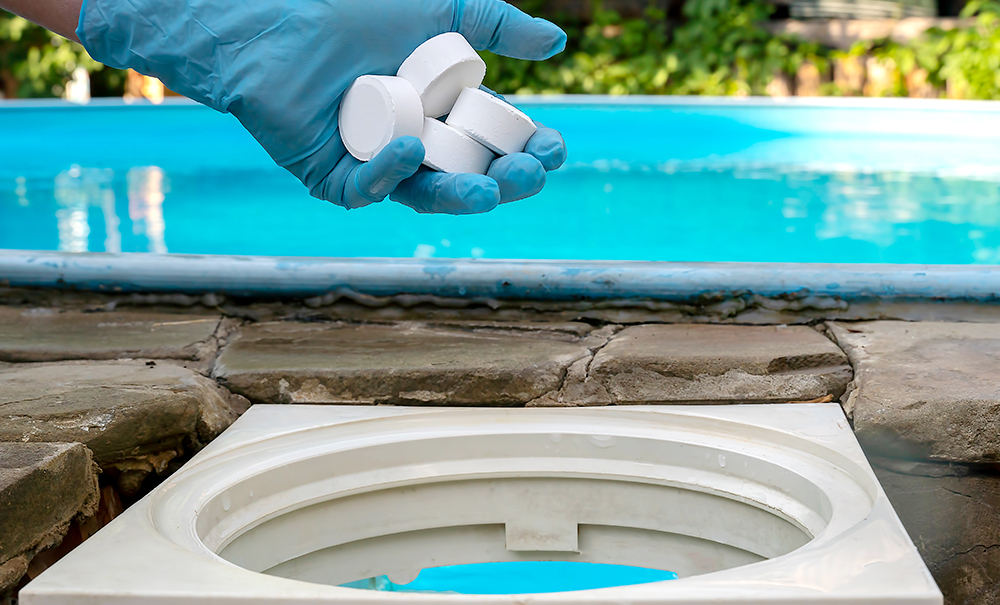
In the winter, the temperature of your swimming pool water drops drastically. The first consequence of this is that in water of 10°C or less, polluting microorganisms develop a lot more slowly. The second is that most people simply don't feel like taking a dip when it’s too cold.
For you, a swimming pool owner, this is good news: it affords you the chance of reducing, and even of halting altogether the treatment of your swimming pool water in the wintertime!
The purpose of treating the water with chlorine or salt is to protect the health of bathers (while also maintaining the aesthetic qualities of the water). In the winter, you no longer have to do any of that, although some adaptations might be required, depending on the type of wintering process you are implementing.
When and how to use the wintering product
Generally speaking, if nobody bathes in winter, you can halt the chlorine or salt treatment and pour a wintering product into the water, which is primarily made of anti-algae compounds and scale inhibitors.

In case of passive wintering
Passive wintering is essential if there are risks of freezing in your region. The water grows in volume when it turns to ice, which creates stress in the piping and installations with risks of serious damage. To remedy this, the level of water is lowered, and the swimming pool’s water outlets and inlets are purged and plugged.
The wintering product is then poured directly into the water, in the quantities recommended by the manufacturer, and the pool is covered.
The installations are also purged and powered down. The swimming pool and the associated network, when totally powered down, no longer run any risk of damage in below-zero temperatures.
Please note that a pool should never be completely emptied: the surrounding soil pushes against the walls continuously and could cause them to collapse or deform. Just imagine what it would cost to repair the pool...

In case of active wintering
Active wintering is lighter to implement than the passive version but must only be done if there is no risk of freezing. Furthermore, the water network continues to operate, so it is a solution that involves increased power consumption and should therefore be avoided with a virtuous swimming pool.
When putting your swimming pool in active wintering mode, first use a shock dose of chlorine to kill off residual bacteria and to ensure that the water is as clean as it can be. Then, add the wintering product following the manufacturer's recommendations.
Only the pump and the filter continue to operate (the other installations are powered down and purged). The winter filtration time corresponds to the water temperature divided by three: if your water is at 9°C, operate the pump for three hours during the coldest period of the day, generally from 5am to 8am.
If the water temperature falls below 3°C, you must run the pump continuously to avoid freezing and the ensuing damage.
We also recommend that you cover your pool to protect the water against organic pollution and UV rays: along with the wintering product, these steps will prevent algae from proliferating, and will facilitate the pool's return to active duty in the spring.
Finally, in situations of active wintering, be extremely wary of electricity cuts! These occur frequently when the weather is cold, and will cause all your installations to shut down and rapidly freeze over: the pool, the pump, the piping, etc. And what is the consequence? Once again, it all entails significant repair costs...
Which is why passive wintering remains the safest and most convenient solution: there is no risk for your swimming pool, regardless of the water temperature, you are not wasting electricity, and you have nothing to worry about during the winter season.
Your swimming pool water in the winter: easy to treat... if no one bathes in it!!
The treatment of swimming pool water is performed to protect the health of bathers: and as people seldom bathe in the winter, you can replace the chlorine treatment with electrolysis (which is not carried out at under 15°C) by pouring in a wintering product that slows the growth of algae.
This product is not recommended if you enjoy bathing in cold water: if that is the case, continue the chlorine treatment. This applies too if you heat your water: the treatment remains the same as the one you apply in the summer.

Finally, remember that it is always possible to save the water of your swimming pool!! With the right filter and some knowledge about the balance of your water, no algae will resist you when you come out of the winter season. Until then, enjoy your winter!
Answer comment
Bonjour, je possède un robot…
Bonjour,
je possède un robot Legend de 2012, ma piscine est traitée au chlore, j'envisage de mettre un électrolyseur et de la passer au sel.
Avant de la passer au sel, je cherche à comprendre si les matériels en place sont protéger contre la corrosion susceptible de provoquer le sel.
SVP, les robots Légend de 2012 sont-ils protéger contre la corrosion induite par le sel?
D'avance merci
Cordialement
D Villet
Answer comment
Bonjour, Merci pour votre…
Bonjour,
Merci pour votre commentaire et voici la réponse de nos experts.
Ce robot étant principalement fait de plastique, il est pas essence presque complètement protégé de la corrosion.
En effet, s'il date de 2012 et qu'il devait rouiller, cela aurait déjà été le cas.
Il est vrai que le sel accélère l'oxydation (la rouille étant une oxydation du fer), mais le chlore, en tant qu'oxydant, a exactement le même effet. De ce fait, que ce soit du chlore ou du sel, si le robot avait du oxyder, cela aurait déjà été le cas avec chlore. et si ce n'est pas le cas il n'y a aucune raison que de l'oxydation apparaisse avec le sel.
en espérant avoir répondu à vos interrogations et merci pour votre confiance en nos produits.
La Team Pentair